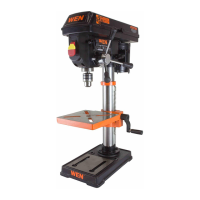11
Fig. E
Fig. F
ASSEMBLY AND ADJUSTMENTS
MOUNT THE DRILL PRESS (Fig. H)
The drill press must be securely fastened through the mounting holes to
a stand or workbench with heavy-duty fasteners (Fig. H). This will pre-
vent the drill press from tipping over, sliding, or walking during opera-
tion.
IMPORTANT: If the stand or workbench has a tendency to move dur-
ing operation, fasten the workbench securely to the floor.
INSTALL THE CHUCK
WARNING: Before any assembly of the chuck to the drill
press spindle, clean all mating surfaces with a non-petroleum
based product; such as alcohol or lacquer thinner. Any oil or
grease used in the packing of these parts must be removed;
otherwise the chuck may come loose during operation.
1. Inspect and clean the taper hole in the chuck and the spindle. Remove
all grease, coatings, and particles from the chuck and spindle surfaces with
a clean cloth.
CAUTION: To avoid damaging the chuck, make sure the
jaws are completely recessed into the chuck. Do not use a
metal hammer to drive the chuck into the spindle.
2 . Align the chuck with the spindle. (Fig. I)
3. Using a wood mallet, firmly tap the chuck upward into position on the
spindle (Fig. J). Alternatively, you can use a block of wood and a regular
hammer, using the wood to cushion the blow and prevent damage to the
chuck.
REMOVE THE CHUCK
If you ever need to remove the chuck:
1. Turn the feed handles to lower the chuck to the lowest position.
2. Place a ball joint separator above the chuck and tap it lightly with a hammer to cause the chuck to drop from
the spindle.
Note: To avoid possible damage to the drill or chuck, be prepared to catch the chuck as it falls.
Fig. H
Fig. I
Fig. J

